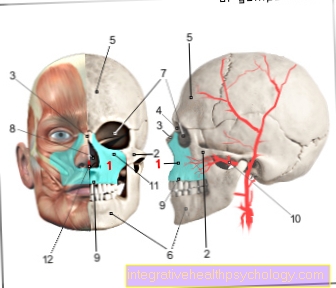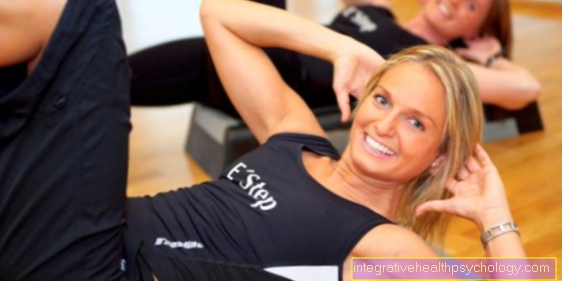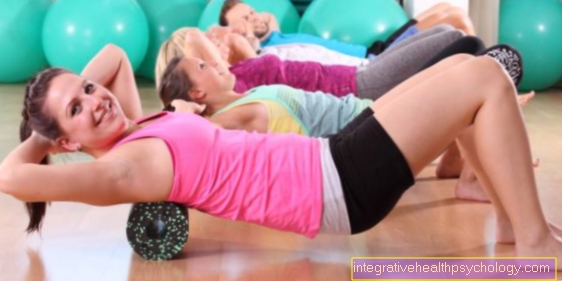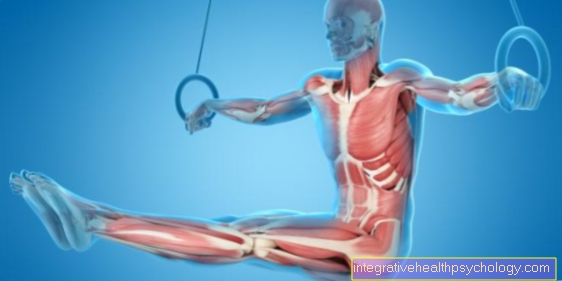Training the abdominal muscles
introduction
As soon as winter draws to a close, preparations for summer begin.
For many women and men, this also means that their sports program begins in order to be fit in summer and to have a beautifully shaped and trained body. An important point is the stomach and the training of the abdominal muscles. A well trained and flat stomach looks good and is the goal of many people.

How often should the abdominal muscles be trained?
A point of contention when training the abdominal muscles is often the frequency of training.
A lot doesn't always help a lot in this case. This means that one shouldn't work the abs every day. Two to three abdominal training units per week are enough to achieve personal goals. This avoids overtraining and reduces the risk of training in a one-sided strength ratio in favor of the abdomen. The training should also always include the antagonistic muscles (opposing muscles). If you want to do something for your abdominal and core muscles more than two or three times, you should resort to holistic exercises such as lunges, push-ups, squats, pull-ups and forearm supports. The abdominal and core muscles are always used in these exercises.
Can I train the abdominal muscles every day?
The abs can be trained every day. This statement is often found among fitness athletes. However, this sentence should be treated with caution.
While you can exercise your abs every day, there are several reasons you shouldn't do so. The muscles do not grow during training, but rather after the training session in the recovery phase. During this time, the muscle regenerates and, depending on the strength of the training stimulus, builds up new muscle cells. It is therefore important to always give the muscles certain breaks. Otherwise it can lead to overtraining and, in the worst case, muscle loss. The rule of thumb therefore applies: the abdominal muscles should be trained every two to three days.
The 5 most important exercises for the straight abdominal muscles
Effective exercises for the straight abdominal muscles are:
- Crunches with bent legs
The starting position is lying on your back. The legs are lifted off the floor so that a 90 degree angle is created in the hip and knee joint. The arms are crossed behind the head and the upper body is lifted off the floor and guided towards the knees. The head should be kept as an extension of the spine so as not to put additional strain on the neck. - Sit ups
The execution is very similar to the crunches. The feet are placed on the floor and the upper body lies flat on the floor. In contrast to the crunch, the entire upper body is now lifted and brought into the upright sitting position. A complete touchdown takes place here. - Forearm support
The forearm support is a good stability exercise for the straight abdominal muscles.This also strengthens the back and remaining core muscles. - Jackknife
The jackknife is another very effective exercise for the abs. By lifting the legs and the upper body at the same time, the entire straight abdominal muscles are trained at the same time. - Belly wheel
Another exercise is the abdominal wheel, which also trains the straight abdominal muscles. Kneeling on the floor, you begin to stretch your body with a wheel and then bend it again. The fitter the abdominal muscles are, the further you can bring your arms forward with the bike.
The 3 most important exercises for the lower abdominal muscles
Athletes who focus on the lower straight abdominal muscles should not skip the following exercises:
- Lying leg raises
The starting position is lying on your back. The arms are on the side of the body or stretched out over the head. Now the outstretched legs are lifted off the floor and brought up into a vertical position. At the highest point the movement is reversed and the legs are brought down slowly and in a controlled manner and kept just above the floor. There the exercise starts all over again. The upper body should rest calmly on the floor when performing the exercise. - Sit-ups on the negative bench
The upper body lies lower than the legs. The legs or feet are fixed in the holding device and the upper body is guided upwards in the direction of the knees / legs as far as possible. At the topmost point, the movement is reversed and the upper body is brought back towards the bench. In doing so, it is not completely discarded at the lowest point, but held and started again. - Reverse crunches
The starting position is lying on your back with your arms bent so that your fingers touch your head. The legs are also raised with the knees close to the head. The lower legs are roughly parallel to the floor. Now the upper body is lifted off and brought with the nose to the knees as close as possible. At the same time, the knees are moved even closer towards the head. At the end point, the tension is held for a short moment and then the movement is reversed again.
The 3 most important exercises for the lateral abdominal muscles
The lateral abdominal muscles should also not be neglected when training the core:
- Beetle
This exercise is not easy to perform, but it is very effective. The starting position is lying on your back. With your arms bent, your fingers touch the back of your head and your legs are stretched out on the floor. Now the legs and upper body are raised, with the diagonally opposite limbs touching each other over the stomach. The right knee and the left elbow touch each other above the stomach, as well as the left knee and the right elbow. Whenever an elbow and knee touch, exhale. When you put your limb down, you breathe in again. - The hip roll
This exercise is a good beginner exercise and easy to learn. Lying on the back, the arms are placed on the floor, spread apart at a 90 degree angle from the body. The legs are bent and lifted off the floor so that the lower legs are above the buttocks. Now you start to roll your legs to one side first. You should always keep your upper back in contact with the ground. The legs are rolled to one side as far as possible and then rolled back over the starting position directly to the other side. The end point should always be sought so that, in addition to strengthening, mobility is also trained. - Abdominal twists on the device
You usually sit on a seat and turn your upper body alternately to the left and right against the resistance of weights or hydraulics. The advantage of exercising in the device is the very low risk of injury, as the exercise is guided and therefore no harmful postures and positions can arise.
Read more on the subject at: Abdominal Muscle Training - The Most Effective Exercises
Abs workout at home
You don't necessarily need equipment to train your abdominal muscles, so you don't always need a gym. There are many exercises that can be done at home to effectively train the abdominal muscles.
The forearm support is a simple exercise that can be done at home on a mat or carpet. You support your upper body with your forearms on the floor. The feet are also supported on the floor and an attempt is made to form a bridge from the toes to the forearms. This will be held as long as possible. Then you can go into the side support. First, the right forearm supports the body on the floor. The right foot is the second point of contact with the ground. The entire body is held in the support position on the right side and forms a line from ankle to head. Here, too, it is about keeping the position as long as possible. This exercise can be used wonderfully using the principle of rotation, since one of the three muscle groups (straight abdominal muscles, left lateral abdominal muscles and right lateral abdominal muscles) is always working while the other two can recover.
Crunches and sit-ups are two other straight abdominal exercises that are easy to do at home. The only difference between the two exercises is that during the crunches the upper body is only lifted slightly from the floor, while during the sit-ups you sit down completely. Straight and side leg and knee raises are also exercises that are well suited for your own four walls. All you need is a comfortable mat and you can do the exercise at any time of the day. From a lying position, the legs or knees (with knees bent) are lifted off the floor and moved over the pelvis.
Read more on the subject at: Abs workout at home
Abs workout without equipment
For the training of the abdominal muscles there are countless exercises that can be performed without aids or equipment.
The leg raise lying on the floor is one of many exercises. Above all, the lower area of the abdominal muscles is strengthened. The stretched legs are raised to a vertical position and then brought back to the floor. The athlete should always be in control and not work with momentum. The crunch lifts the upper body off the floor and moves it towards the knees. The arms are bent and the fingers grip the sides of the back of the head. The feet can be placed on the floor or raised from the floor. Crunches train the straight abdominal muscles. Cross-legged crunches are a variation on normal crunches. First the right foot is placed on the left, and then the left foot on the right knee. Now the left elbow goes to the right knee, which activates the lateral abdominal muscles. Then the right elbow is brought to the left knee and the other side also trained.
Another exercise for abdominal exercises without equipment or aids is the hip lift on the floor. The starting position is on your back on the floor. The arms are spread sideways from the body and lie on the floor for support. Now the stretched legs and the hips are lifted off the floor and led vertically upwards towards the sky. The arms are now primarily used to balance and support the exercise. The lateral abdominal muscles can be trained with the Russian Twists. The starting position is sitting on the floor, a mat or a rug. The feet are set up so that the legs are bent. The hands are folded in front of the chest. From this position, both hands are simultaneously moved first to one side and then to the other. On each of the sides, both hands are pressed briefly on the floor before turning to the other side. The focus is always on the hands so that the head rotates gently with the thoracic and cervical spine.
Abs workout for beginners
The abdominal exercises also have simple exercises for beginners and more difficult exercises for advanced and experts.
The simple exercises also include abdominal exercises that are performed in the device. These include classic abdominal trainers and devices such as "Abdominal Crunch". Here the focus is on the pure strength development of the abdominal muscles.
In the free exercises, the athletes have to keep their balance independently and the coordination requirements are significantly higher. Therefore, not all free abdominal exercises are suitable for beginners. The classic crunch and sit-up are exercises that can be performed by anyone. This is about the flexion in the trunk, which contracts the abdominal muscles. Lying leg raises is another beginner exercise. The plank and side plank can also be performed by all athletes, as the position is clear and the holding time is important.
Read more on the subject at: Abs workout for beginners
Abs workout for women
When it comes to training the abdominal muscles, women and men sometimes differ significantly. While the focus for men is the six-pack, a woman's stomach should be flat and not too muscular. Men also prefer to train with weights, whereas women prefer to use their own body weight and train without aids.
The crunch with outstretched arms is ideal for the upper and lower abdominal muscles. Lying on your back, put your feet up so that your legs are bent. The arms are stretched out over the head and placed on the floor. Now arms and upper body are lifted off the floor and raised as far as possible so that the lower back is still on the floor. Then arms and upper back are brought down again and held just in front of the floor. From this position you start lifting again.
An exercise that also involves the lateral abdominal muscles is the twisted crunch. The legs are positioned vertically over the buttocks while lying on their back. The arms are bent and the fingers grip the back of the head at the sides. Now move the opposite elbow alternately towards the knees. The torso is lifted off the floor and the right elbow moves towards the left knee and the left elbow moves towards the right knee.
The forearm support is another exercise that is very popular with women. A bridge is formed from ankles to forearms, while the body is held in a horizontal position parallel to the floor. The side forearm support is also popular with women to train the side abdominal muscles.
Read more on the subject at: Abs workout for women
Abdominal muscle training during pregnancy
The training of the abdominal muscles can generally be continued during pregnancy. However, you should pay attention to a few aspects to avoid injuries. The straight abdominal muscles should be excluded from training after a certain phase of pregnancy, after consultation with the doctor, so that no rectus diastasis occurs (in this case the straight abdominal muscles slide apart). In addition, tightening the straight abdominal muscles could put additional pressure on the unborn baby. Therefore, during pregnancy, women should concentrate on exercises for the lateral and oblique abdominal muscles.
The side plank is a good exercise that strengthens the core holistically and focuses more on the lateral abdominal muscles. Depending on your ability, you can choose your feet or knees as contact points on the floor. The version with the knees is recommended for beginners for the time being. The classic planking pose can also be used for training. You go into the reclining or forearm support and try to hold the position as long as possible. You can also try to pull the stomach towards the spine.
Read more on the subject at: Abs workouts during pregnancy
Abs workout after giving birth
After the birth, postnatal exercises should first be carried out after consulting a doctor and midwife. Then you can start with a gentle abdominal muscle training. If the doctor and midwife give the go-ahead, you can begin with light strengthening exercises for the abdomen.
Light leg raises with bent legs are gentle and still strengthen the abdominal muscles. The beetle is also a good place to start. In a diagonal alternation, the elbows and knees of the opposite limbs are brought together. Cycling is also a good strengthening and agility exercise for women after giving birth. Tightening the legs activates the abdominal muscles and keeps them involved in the movement while cycling. The forearm support or the push-up position are also effective if the abdominal muscles are to be strengthened after giving birth.
The following recommendation applies to all exercises: If you experience pain, you should always stop training. It should start with gentle exercises and a low level of stress. If you are unsure, you should always ask your doctor and / or midwife for advice. In addition, a postnatal exercise should be carried out beforehand. A strengthening program for the abdomen / core should be started at least three months after delivery.
Read more on the subject at: Abdominal muscle training after pregnancy
Abdominal muscle training while standing
An exercise that can be done while standing, and in which the abdominal muscles are trained, are the squats, or squats. The starting position is hip-width apart. A dumbbell (alternatively a bottle of water) should be held in each hand. The buttocks are moved back and down and held in an end position. The thighs are roughly parallel to the floor and the stomach is tense as much as possible. This position is held for ten seconds before you then fully straighten yourself up again.
Another exercise is the ABC of Medicine Ball. A medicine ball is held over the head with outstretched arms. From this position the medicine ball is moved back and forth in front of the body and letters are written in the air. The arms should always be stretched out. The tension and movement in the trunk effectively trains the abdominal muscles.
Another exercise while standing is the diagonal kicks with arms and legs. From the upright position, first extend the right leg, bring it up and cross it diagonally with the left arm. Both limbs are returned to the starting position and the left leg and right arm perform the same movement. The diagonally curved limbs cross each other in front of the body and are then always returned to the starting position. The stomach is tense and the upper body should be kept as still as possible.
Abdominal muscle training while sitting
Often times, lack of time is the greatest enemy of sports. Many people therefore prefer to train in a very time-saving way. Some abdominal exercises can be done while sitting. This saves time and allows part of the training to be carried out at the workplace.
One exercise is leg lifts, in which the legs are lifted slightly from the floor and held in a sitting position at the same time or alternately. The longer the legs stay off the floor, the more effective the exercise is. The arms remain on the table and lightly support the body.
Another variant is stretching your legs and doing the diagonal crunch while sitting. When stretching the legs, the lower legs are alternately lifted from the floor and the legs fully extended so that the entire leg is parallel to the floor. This exercise should be repeated at least ten times. The diagonal crunch works similarly to the beetle lying down. The hands grip the back of the head with the fingers and the elbows move alternately to the diagonally opposite knee. Not only the straight, but also the lateral and oblique abdominal muscles are trained.
Other exercises for the lateral abdominal muscles
Many exercises can also be found in the lateral abdominal muscles, by means of which the muscles are strengthened and also muscle building can be carried out.
The lateral forearm support is a static exercise for strengthening the lateral abdominal muscles. The body is supported on the outside of a foot (e.g. the right foot) and the forearm on the same side (right forearm) on the floor.The body forms a line from the ankle to the head that should not "sag". The stability in the trunk should therefore be maintained.
Another exercise is the beetle / diagonal crunch, in which the right elbow (or left elbow) is alternated with the left knee (or right knee). Elbows and opposite knees should meet roughly above the stomach / trunk and ideally touch briefly. Other exercises include the Russian Twist, side leg raises, hip rolls, windshield wipers, side crunches, etc.





























